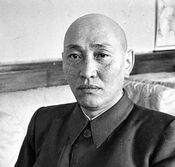Chandan Republican Revolution: Difference between revisions
(Created page with "{{Region icon Kylaris}} Category:Chanda Category:Kylaris {{for|the conflict during the Great War|Chandan War of Independence}}{{for|the armed c...") |
mNo edit summary |
||
| (13 intermediate revisions by the same user not shown) | |||
| Line 1: | Line 1: | ||
{{Region icon Kylaris}} [[Category:Chanda]] [[Category: | {{Region icon Kylaris}} [[Category:Chanda]] [[Category:History of Chanda]] | ||
{{for|the conflict during the [[Great War (Kylaris)|Great War]]|Chandan War of Independence}}{{for|the | {{for|the conflict during the [[Great War (Kylaris)|Great War]]|Chandan War of Independence}}{{for|the conflict between the factions of the People's Liberation Army of Chanda|Chandan National Revolution}} | ||
The '''Republican Revolution''' ([[Chandan language|Chandan]] ''' | [[File:Wu Khar.jpg|175px|thumb|right|[[Wu Khar]], considered the main architect of the Republican Revolution.]] | ||
The '''Republican Revolution''' ([[Chandan language|Chandan]] '''𑐀𑐫𑐩𑐵𑐑𑐲𑐵𑐑𑐵 𑐄𑐮𑐸𑐲𑐲𑐕𑐶𑐮𑐶𑐎 𑐴𑑁𑐲𑐑𑐵𑐮''', ''Aymagsaga Uluschilik Husgal'') was a a political process in [[Chanda]] that was led by Chandan President [[Nurlan Sabir]], the cofounder of the Chandan National Front and later the [[Chandan Socialist Birlik Front]]. According to Sabir and other supporters, it consisted of "ideological revolution" by adopting [[Birlikism]] as a national ideology, and a "republican revolution" through {{wp|state-building}} and {{wp|nation-building}}. | |||
It is generally considered to have started with the outbreak of the [[Chandan National Revolution]], in | It is generally considered to have started with the outbreak of the [[Chandan National Revolution]], in February 1949. Historians disagree on the exact date the revolution was completed; while the ASBH announced the end of the Revolution with the [[Declaration of the Birlikist Republic]] in April 1951, many historians agree that the process behind the Revolution continued for years after. At its latest, the Revolution is said to have ended by the end of the decade, during the [[Satrian Wars and conflicts|Second Satrian War]]. | ||
Latest revision as of 02:46, 30 April 2021

The Republican Revolution (Chandan 𑐀𑐫𑐩𑐵𑐑𑐲𑐵𑐑𑐵 𑐄𑐮𑐸𑐲𑐲𑐕𑐶𑐮𑐶𑐎 𑐴𑑁𑐲𑐑𑐵𑐮, Aymagsaga Uluschilik Husgal) was a a political process in Chanda that was led by Chandan President Nurlan Sabir, the cofounder of the Chandan National Front and later the Chandan Socialist Birlik Front. According to Sabir and other supporters, it consisted of "ideological revolution" by adopting Birlikism as a national ideology, and a "republican revolution" through state-building and nation-building.
It is generally considered to have started with the outbreak of the Chandan National Revolution, in February 1949. Historians disagree on the exact date the revolution was completed; while the ASBH announced the end of the Revolution with the Declaration of the Birlikist Republic in April 1951, many historians agree that the process behind the Revolution continued for years after. At its latest, the Revolution is said to have ended by the end of the decade, during the Second Satrian War.